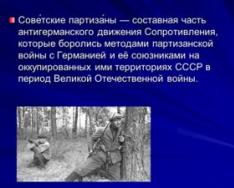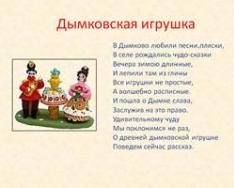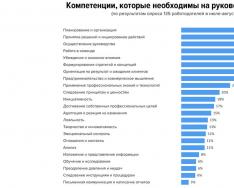MBDOU No. 74 Educator: Loskutova D.V.



The technique for making a Dymkovo toy is very simple. The toys are made from red clay mixed with river sand. The shape is sculpted in parts. The individual elements are connected to each other with liquid clay. The seams are wiped with a damp cloth.

After sculpting, the toy is dried and fired.

The next stage of work is bleaching. The toy was immersed in a solution of ground chalk diluted in milk. The toy turned into dazzling white and was ready for painting.

Then traditional patterns were applied: cells, stripes, circles, ovals, dots.

The Dymkovo lady is very elegant. On the head there are certainly curls, hats, kokoshniks. There is a cape on the shoulders and puffy sleeves. There are frills at the bottom of the skirt or apron. In their hands are a handbag, an umbrella, a dog, a rocker, etc. The craftswomen generously “scattered” circles, cages, large and small peas across the white background. Look how beautiful this soul girl is, her scarlet cheeks are glowing, her outfit is amazing.

Dymkovo cavaliers, dignified generals, with a sense of self-esteem. More often they are depicted on horseback or paired with a lady. With ribbons and bows, Arm in arm with dandies, We walk in pairs, We swim by as peahens.

Clay horses race on stands as hard as they can. And you can’t hold on to the tail if you lose the mane.

An unknown bird has appeared - everyone marvels at it. It doesn’t sing or fly, Everything is on fire and blazing... This bird is not simple, Painted, golden. It’s just a miracle - a trinket, Its name is a folk toy!

To this day, the Dymkovo toy continues to delight us with its brightness, colorfulness, and festivity. The Dymkovo toy craft is preserved thanks to Dymkovo craftswomen from the city of Kirov. We are famous toys, Foldable and ok, We are famous everywhere, You will like us too!
Presentation “Dymkovo Toys” for children 4 – 5 years old Portal “About Childhood” “Presentation Master” Author: Motkova Lyudmila Vladimirovna, teacher of the MBDOU combined type “Kindergarten 76 Yoshkar-Ola “Solnyshko”, Republic of Mari El
Portal “About Childhood” “Presentation Master”

On the banks of the Vyatka River there is a village - Dymkovskaya Sloboda. Portal “About Childhood” “Presentation Master”

For a long time, skilled craftsmen have been making bright, elegant toys in this village. Yes, toys are not simple! They are made of clay. Portal “About Childhood” “Presentation Master”

The master takes a piece of clay and begins to sculpt a figurine from it. And the clay is soft! Softer than plasticine. Portal “About Childhood” “Presentation Master”

He molds the toy and goes straight into the oven! Portal “About Childhood” “Presentation Master”

From the fire and heat the figurine dries out and becomes hard as a pebble. Portal “About Childhood” “Presentation Master”

When the toy cools down after the oven, the master paints it all white. Portal “About Childhood” “Presentation Master”

When the white paint dries, the real magic begins!.. The master takes bright paints and begins to paint the toy with multi-colored patterns. Portal “About Childhood” “Presentation Master”

The patterns are very simple. These are straight and wavy lines, circles and ovals, peas and dots. Portal “About Childhood” “Presentation Master”

And the toys come out - just a sight for sore eyes! “Presentation Master” Portal “About Childhood” Deer - golden horns! There are stripes and polka dots on the chest.

Dymkovo turkey is good! You won't find anything better in the world! Red, blue, gold - that’s how painted everything is! Portal “About Childhood” “Presentation Master”

The horse will run to the carousel. Emelya jumped onto the horse. He smiled, whistled, whistled and galloped! Portal “About Childhood” “Presentation Master”

Introduce children to the history of the Dymkovo toy; Show the characteristic features of painting a Dymkovo toy; Learn to identify the elements of the geometric pattern of Dymkovo painting (circles, straight and wavy lines, checkered patterns, pea dots). Develop aesthetic perception, sense of rhythm, color. Foster a love for Russian folk art

People lived in the same village. When it was cold outside and the winter frost froze the ground, the stoves in the houses flooded, smoke enveloped the roofs, so much so that nothing was visible. Just smoke... So they called the village Dymkovo. The adults in that village worked from morning until late evening: they dug the ground, prepared food, herded cattle, and the children joked, played in the meadow, and sang songs. They didn't have toys like you back then. And the adults began to think: how to please the children. They collected clay from the river bank, sculpted various funny figures, fired them in the oven, covered them with chalk diluted in milk, and painted them. For the “whistle” holiday, craftsmen from the Dymkovo settlement sculpted clay whistles in the shape of horses, rams, goats, and ducks. This is how Dymkovo toys appeared. Bright, cheerful, playful, these toys lead us into their own special, fabulously beautiful world.

Dymkovo toy handicraft. Each is the creation of one master. From sculpting to painting, the process is creative and never repeated. There are not and cannot be two identical products. Each toy is unique and one of a kind. Clay for production was traditionally mined in the settlement of Dymkovo, which is on the low-lying bank of the Vyatka River near the city of Kirov. The collected red clay in the settlement used to be chopped with a shovel and mixed with fine river sand - there is a huge river beach nearby. So, after mixing, the clay was turned over many times and moistened with water. In the old days they used to knead it with their feet. Now the craftswoman does not dig clay and does not knead it. The material is prepared by machine in one of the ceramic production facilities. Clay comes to the workshops in finished form - plastic packaging-briquettes of 10 kilograms.


Each toy, from a piece of clay to a finished sculpture, is made by one master. If earlier a craftswoman spent a lot of time preparing clay and whitewashing, now more attention is paid to the process of sculpting and painting a toy. Pieces of clay are separated and rolled into balls. The balls are used to make individual parts of the toy. The Dymkovo toy is different in that it is made not from one piece of clay, but from several. A ball of clay is rolled into a pancake, a cone is made from the pancake - the lady’s skirt is ready. It is hollow inside with walls 4-6 mm thick. The walls of the cone are leveled by turning the workpiece in your hands. Then, moistening with water, attach the sausage handles and the head ball. All made from small pieces of clay. All the main elements of the toy are done first. All joints are smoothed with a damp cloth. It turns out like a single whole. Then they decorate the toy with details - kokoshnik, muff, handbag, dog, braids, hat, etc.

Dry the molded workpiece for 3-5 days, sometimes longer, in air. In the old days, the toy was fired in Russian kilns. Placed directly on firewood or on an iron baking sheet. The clay begins to heat up and soon becomes as if transparent - it glows with an even red color in the fire. At this point, the firing process ended, and the toys slowly cooled in the extinguished oven. Now toys are fired in muffle furnaces at temperatures of more than 1000 degrees. This high temperature gives the clay even greater strength. The ovens are quite large and toys are loaded into them in batches. Again, craftswomen do not have precious time taken away from non-creative processes.


After the oven, the workpiece turns out to be brownish-red. For whitewashing in the old days they used a solution of chalk in milk - they dipped the whole toy. The milk on the surface sours and forms a strong, bright film of casein glue. Whitewashing is a characteristic feature of the Dymkovo toy. Nowadays whitening is done using tempera white, which is applied with a brush. The final part of the process is painting. First, let's talk about the old traditional method of painting: Dry paints were ground with an egg, peroxided kvass or vinegar was added. The color scheme was not rich, only basic tones. Compositions ranging from soot to fuchsin and chromium were used. These paints seemed to give up some of their color to the workpiece and sounded muted. In the 20th century, they used gouache, also diluted on an egg. Now they use bright acrylic paints - they are very durable.

Brushes are used mostly soft, of different sizes. Thin brushes allow the craftswoman to introduce small details into the plot - this is not always good, as it leads to oversaturation of the plot. Pieces of gold leaf or gold leaf - a mixture of zinc and copper - are glued on top of the paint. They shine and, together with bright colors, give a dazzling charm to the Dymkovo toy.


To use presentation previews, create a Google account and log in to it: https://accounts.google.com
Slide captions:
Dymkovo toy The presentation was left by Meri Ashotovna Avakyan, teacher of the first quarter category of MBDOU No. 2, Lermontov
On the wide bank of the Vyatka, opposite the city of Kirov, is the ancient village of Dymkovo.
The glory of the Russian painted Dymkovo toy has gone far.
For a long time, clay toys depicting horses, deer, ducks, turkeys, horsemen, and ladies were sculpted here.
The Dymkovo toy is one of the oldest crafts in Russia; it has existed on Vyatka land for more than four hundred years. The appearance of the toy is associated with the spring holiday of Whistling, for which the female population of the Dymkovo settlement made clay whistles.
They made funny toys from clay and decorated them with bright patterns.
The ornament contains mainly simple forms: circles, dots, wavy and straight lines, and a cage. All colors are bright.
The revival of the craft took place in Soviet times in the 30s of the 20th century and is associated with the name of A.I. Denshin, who managed to persuade hereditary craftswomen E. Penkina, E. Koshkina not to give up their craft and organize the “Vyatka Toy” artel.
Later the circle expanded, and new everyday and fairy-tale scenes were introduced into the toy
The Vyatka River, where the village of Dymkovo is now located
On the topic: methodological developments, presentations and notes
Summary of the final entertainment in the first junior group on the topic: “Toys.” Objectives: Educational area “Communication”: - Contribute to the expansion of children’s active vocabulary on the topic: “Toys”. -...
A story about a Dymkovo toy “In the workshop of a Dymkovo toy”
Program content To instill in children respect and interest in folk crafts To consolidate ideas about the process of creating toys To learn to create an image using acquired skills and modeling techniques.F...
DIY musical toys. Musical toys and games.
To play music at home, you need musical toys and instruments. They are sold in stores, but some of them can be made with your child at home from scrap materials. So the baby at the same time pr...
Introducing preschoolers to Russian clay toys using the example of the Filimonovskaya toy
The work reveals the theoretical part for working with children to familiarize them with the Filimonov toy....
Exchange rates

